Microorganisms play an important role in wastewater treatment indicators during the commissioning, operation and process adjustment of biochemical systems in wastewater treatment plants.
By microscopically checking the microbial status in the activated sludge, the water treatment enterprise can obtain the relevant trait information of the activated sludge, which plays a guiding role in the production.
The previous article “Microflora Analysis of 24 Microorganisms and Their Guiding Significance in Water Treatment (part 1)” mentioned the first 12 species of 24 microorganisms used as indicators. In today’s article, there will be information on the remaining 12 species of microorganisms.
| Parmecium | Non-activated sludge protozoa | Length: 180-300μm, width: 42-75μm |
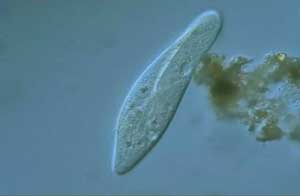 |
||
| Form | The paramecium has a larger body shape in the original vivid material, and the body has a cylindrical shape. Its middle half is the widest, the front half has a concave groove on the ventral surface, and the bottom of the middle groove has an elliptical cell mouth.
The paramecium is evenly covered with cilia around the body. Some of the cilia at the back end are a little longer. The outer surface of the epidermis is relatively transparent, and the endoplasm is filled with granular substances. There are more food bubbles in the paramecium, two of which are located in the body length of one quarter and the other in the body three quarters. |
|
| Zoology | Paramecium is mainly based on bacteria, and the most suitable ecological environment is medium pollution and multi-stain. It occurs in a large amount in an environment where the dissolved oxygen concentration is hardly detected. In the activated sludge, when the degree of purification is poor, it will appear more. | |
| Arcella | Non-activated sludge protozoa | Shell diameter: 100-150μm, shell height: 50-75μm |
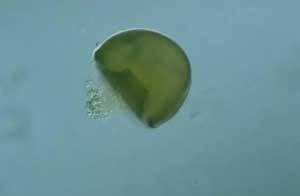 |
||
| Form | The dorsoventral view of the shell is round and looks like a cover. The side view is flat and the back is highly sturdy and the entire shell is semi-circular.
The height of the shell is about one-half of its diameter. The shell is usually brown or yellow and occasionally has a colorless and transparent shell. Arcella have finger-like pseudopods that protrude from the shell holes and do not exceed 5 or 6. Its internal quality contains many food foams and storage granules. |
|
| Zoology | Arcella are mainly plant worms and unicellular algae. The illuminating water body is its most suitable living environment. Arcella often appear in large amounts in the low BOD load of activated sludge, and the sludge residence time is too long. | |
| Uronema | Non-activated sludge protozoa | Length: 30-50μm, width: 15-24μm |
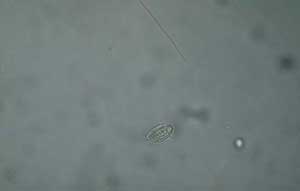 |
||
| Form | Uronema has a slender oval shape with a length to width ratio of approximately 2:1. Usually, the front half is narrower than the second half.
The front end is flat and often has a slight depression, which is the narrowest part of the body. The back end is wider and rounder. The outer membrane has longitudinal stripes. Uronema has a full body of cilia with a long tail hair at the back end. |
|
| Zoology | Uronema uses bacteria as its main food source and has high ecological tolerance. Uronema is a neutral species in nature. In activated sludge, it is often found that in the case of low and high dissolved oxygen, the BOD of treated water is also high. | |
| Colpidium | Non-activated sludge protozoa | Length: 60-95μm, width: 20-25μm |
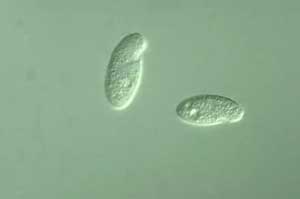 |
||
| Form | Colpidium has a long oval or nearly long bean shape, and the rear half tends to be wider than the front half.
The ventral surface of the front end is bent and a depression is formed in one-third of the front part of the abdomen, and the rear end is rounded. The cilia distributed throughout the body are quite dense and uniform, and the endoplasm is relatively transparent. |
|
| Zoology | Colpidium uses bacteria as its main food and also eats miniature flagellates. It is present in the polluted water body in the natural environment and is rarely found in the odious water.
In activated sludge, it is often found in the case of high BOD load and low dissolved oxygen. At the same time, fluctuations, trichomoniasis, etc. can be observed, which is a representative of non-activated sludge. |
|
| Metopus | Non-activated sludge protozoa | Length: 120-160μm, width: 30-60μm |
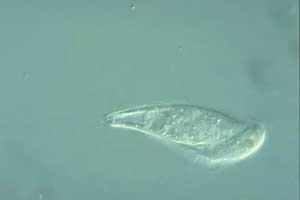 |
||
| Form | The Metopus body is formed into a spindle shape, the middle abdomen is relatively enlarged, and the lip edge starts from the front end and twists in the diagonal direction to the ventral surface.
Metopus has a sparse scaly body that is wide and distinct, with a telescopic bubble at the end. |
|
| Zoology | Metopus uses bacteria as a food source and often appears in activated sludge that can only detect traces of dissolved oxygen. For activated sludge systems, if the amount of Metopus is superior, the treated water is mostly turbid and BOD is increased. | |
| Trachelophyllum | Neutral activated sludge protozoa | Length: 45-55μm, width: 10-14μm |
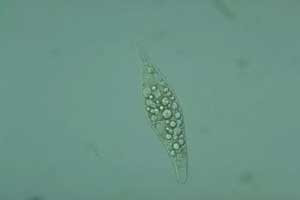 |
||
| Form | Trachelophyllum has a body length that is 4 times the length of the length of the appointment. It is spearheaded or shaped like a needle blade. Highly flat, flexible and easy to change, often for gliding swimming.
One-third of the body of the Trachelophyllum body is sharply cut to form a “neck.” The front end is truncated and straight or slightly convex to form a dome. The widest part is often at the back of one third. The back end is a bit thin and obtuse. Trachelophyllum cilia distribute throughout the body, and the endoplasm contains many storage granules. |
|
| Zoology | Trachelophyllum uses bacteria as its main food and also preys on small protozoa. It has a wide range of environmental conditions in activated sludge.
Trachelophyllum mainly occurs in the stage where the activated sludge is in a non-optimal state, which is an important reference for judging whether the activated sludge turns from bad or deteriorates. |
|
| Amphileptus | Neutral activated sludge protozoa | Length: 120-150μm, width: 35-45μm |
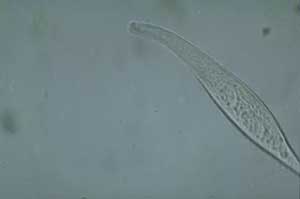 |
||
| Form | The Amphileptus body is flattened in a flask shape with a long “neck” with a slightly curved side at the front end. The cell mouth is in the ventral edge of the “neck” and is crack-like. Amphileptus has a uniform distribution of cilia throughout the body, with long cilia along the cracked cell. Its body is relatively transparent and the expansion and contraction bubbles are irregularly distributed. |
|
| Zoology | Amphileptus is a carnivorous protozoa with ciliates, worms, polyphages and other solid ciliates. It is often indicated that when the water quality BOD is relatively low, it is an indicator organism for judging whether the water quality is good.
However, Amphileptus consumes sessile ciliates that have a clarifying effect on water quality. |
|
| Litonotus | Neutral activated sludge protozoa | Length: 80-110μm, width: 14-15μm |
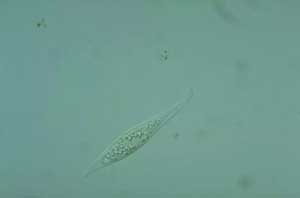 |
||
| Form | Litonotus has a slender flaky body or a lancet. Most Litonotus will mutate more.
The widest part is located in the middle and is thin from the middle to the front and back. The “neck” is quite long, with the front end turning towards the ventral surface between one-third and one-half of the full length, with the cell mouth on the ventral side of the “neck.” The Litonotus cilia fraction is on one side of the body and the endoplasm is quite transparent. |
|
| Zoology | Litonotus is a carnivorous ciliate with flagellates and other small ciliates as the main food source. In the natural environment, it is most suitable to be a dirty or polluted water body. Litonotus often occurs in activated sludge during the recovery of activated sludge systems. | |
| Chilodonella | Neutral activated sludge protozoa | Length: 78-250μm, width: 36-124μm |
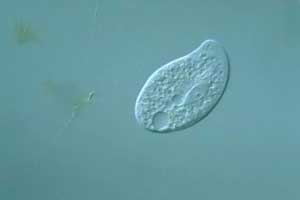 |
||
| Form | Chilodonella is more transparent, irregularly elliptical, and the rear half is wider than the front half. The back is more or less convex, and a little turn to the left to form a sharp corner that is not very prominent.
The Chilodonella cell is rounded on the ventral surface near the front end, and the cell mouth can protrude slightly outside of the body when feeding. There are many telescopic bubbles, which are irregularly distributed around the body. |
|
| Zoology | Chilodonella is based on algae and bacteria and has a strong environmental adaptability, mainly during the period from deterioration of activated sludge to recovery. | |
| Etosiphon | Neutral activated sludge protozoa | Length: 25-30μm, width: 18-22μm |
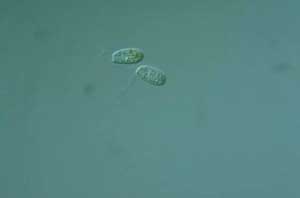 |
||
| Form | Etosiphon has a broad oval shape. The front end is straight or slightly sunken, the back end is round, the back side is flat, and the film is relatively hard and does not change shape.
It has 7 or 8 longitudinal grooves. The cell mouth is located at the front end of the depression. There is a tubular pharynx. Two equally elongated flagella protrude from the cell mouth. One is always swiping in the front and the other is dragging in the back, there may be gliding |
|
| Zoology | Etosiphon is likely to rely on plant-based saprophytic nutrition to live, whether it can swallow bacteria has not been conclusive. Its appearance treatment water BOD is mostly lower, and the tubeworm in the ditch is close to the activated sludge protozoa. | |
| Peranema | Neutral activated sludge protozoa | Length: 30-80μm, width: 12-28μm |
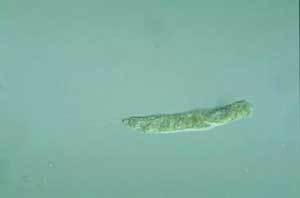 |
||
| Form | Peranema has a large change when it is at rest, no form, and always lengthy when in action.
The back end is wider and truncated or rounded, and the body is tapered from the rear end. Thick flagella protrude from the front end is almost the same length as the body. Peranema is pointing straight ahead, and the other thin and short flagella stick out and then bends back and attach to the membrane of the body, which is not easy to see. |
|
| Zoology | Etosiphon is likely to rely on plant-based saprophytic nutrition to live, whether it can swallow bacteria has not been conclusive. Its appearance treatment water BOD is mostly lower, and the tubeworm in the ditch is close to the activated sludge protozoa. | |
| Oxytricha | Neutral activated sludge protozoa | Length: 30-156μm, width: 54-65μm |
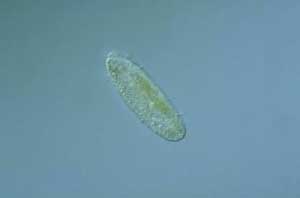 |
||
| Form | Oxytricha has a long, oval body, which is soft and easy to change. It is about 2.5 times the body length. One-third of the front narrow and narrow, from then onwards Zhejiang expansion, abdominal flat back more or less protruding.
The rim area is larger, with 8 anterior tentacles, 5 anterior, and 3 obliquely aligned. There are 5 abdominal tactile hairs and 5 hip ciliary hairs; the endoplasm contains a small number of vesicles. |
|
| Zoology | Oxytricha feeds on bacteria, unicellular green algae, and small flagellates. The ecological tolerance is strong, and it can tolerate either oligos or contaminated water.
There is not much in the activated sludge, and the tip caterpillar appears to be intermediate activated sludge protozoa when the treated water has a higher BOD than the E. urticae. |
|
Title:
Microflora Analysis of 24 Microorganisms in Water Treatment (part 2)
Source: https://www.irohedp.com/microflora-analysi-water-treatment-2/